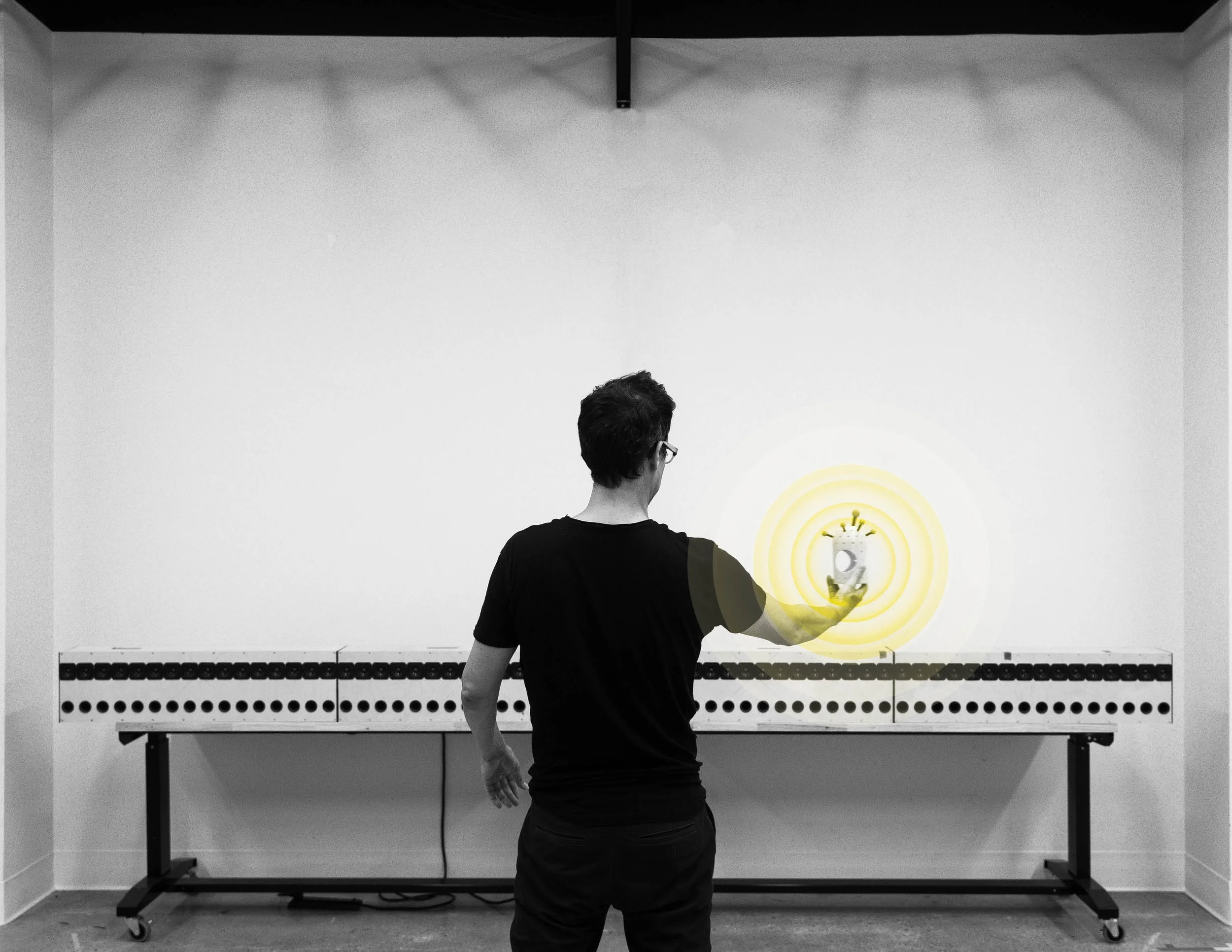SoundHolo
Sonically Augmenting Everyday Objects and the Space Around Them
SoundHolo is an interactive spatial audio platform that enables any physical object to emit sound without embedded electronics. Using wave field synthesis and motion tracking in a 20x30x12 foot room with a 64-channel speaker array, this system creates 3D audio experiences that multiple users can perceive simultaneously.
Daniel Rosenberg Munoz, Miles Scharff, Brandt YouRan Li, Kimberly Blacutt
Tools: Unity, Max MSP, Motive, OptiTrack, Adobe Creative Suite, Rhino
Skills: User Research, Spatial Audio Design, Technical Documentation
SoundHolo concept video
tEI ‘25 conference presentation
My Contributions
Research & Design Framework
Conceptualized and organized the SoundHolo Matrix, a foundational design framework categorizing 18 different sonic augmentation possibilities across sound particles, curves, and fields
Developed methodologies for visualizing invisible sound as a design material in 2D graphics and documentation
Developed application scenarios for immersive soundscapes, storytelling merchandise, and spatial auditory displays
User Experience Research
Designed comprehensive user study protocols and created participant worksheets
Recruited and facilitated research sessions with 8 participants
Developed Unity scripts to precisely position 3D sound objects for controlled testing environments
Analyzed perceptual efficacy data comparing mid-air sounds versus object-attached audio
Visual Communication & Documentation
Created all graphics, diagrams, and visual frameworks for the academic paper
Developed innovative methods for representing spatial audio concepts in static media
Designed complete document layout and visual identity in Adobe InDesign
Photographed and edited all system documentation and user study imagery
Technical Implementation
Programmed Unity scripts for dynamic 3D sound placement and motion tracking integration
Collaborated on software workflow connecting Motive, Unity, and Max MSP platforms
Contributed to system architecture design for real-time audio spatialization
Media Production
Directed and edited demonstration videos showcasing system capabilities
Created detailed storyboards and motion graphics in Figma and After Effects
Produced technical documentation photography for academic publication
System diagram
room set-up
software pipeline
Applications
user studies
Impact & Recognition
This work was accepted at TEI '25 (Tangible, Embedded, and Embodied Interaction), an international ACM conference. I attended as a student volunteer in Bordeaux, France, representing this research to the global HCI community.
The project contributes new interaction paradigms for sonic augmentation, expanding possibilities for tangible user interfaces beyond traditional embedded electronics approaches. Our framework provides HCI researchers with systematic design options for incorporating spatial audio into interactive applications.
Process & Reflections
On visualizing the invisible: One of the biggest challenges I faced was figuring out how to represent sound in static graphics for an academic paper. How do you show something you can't see? I went through so many iterations trying to find visual languages that could communicate spatial audio concepts clearly.
Organizing the matrix: The SoundHolo Matrix became this central organizing principle for our whole paper, but it started as messy conversations with Daniel about all the different ways sound could behave in space. I kept sketching out different types of sound movements and configurations (particles vs. curves vs. fields), trying to make sense of all the different options there were, and how they could move directly attached to objects or in relation to them. Developing the matrix and laying everything out systematically felt like we'd created a new vocabulary for spatial sound design.
User study worksheets: Getting the worksheets right took a lot of back-and-forth with Daniel. We kept refining how to ask people to mark where they heard sounds and what confidence levels made sense. The visual clarity felt really important since we were asking participants to communicate something pretty abstract - like drawing the location of an invisible sound source.
The video challenge: I hadn't done much video editing before this, but I wanted to tackle it. The storyboard helped me plan out all the cuts and transitions before jumping into Premiere and After Effects. It was satisfying figuring out how to make spatial audio concepts come across clearly in a regular 2D video format.





